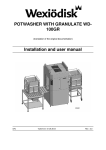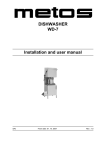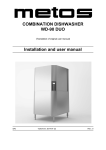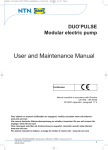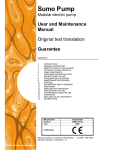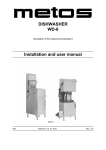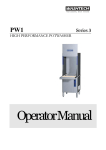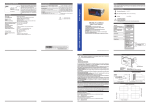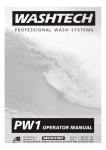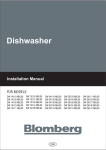Download POTWASHER WITH GRANULATE WD-90GR HC
Transcript
POTWASHER WITH GRANULATE WD-90GR HC Installation and user manual S/N: De la date: 01. 08. 2006 Rev.: 21.6.2006 Rev. Dear Customer, Congratulations on deciding to choose a Metos appliance for your kitchen activities. You made an excellent choice. We will do our best to make you a satisfied Metos customer like thousands of customers we have around the world. Please read this manual carefully. You will learn correct, safe and efficient working methods in order to get the best possible benefit from the appliance. The instructions and hints in this manual will give you a quick and easy start, and you will soon note how nice it is to use the Metos equipment. All rights are reserved for technical changes. You will find the main technical data on the rating plate fixed to the equipment. When you need service or technical help, please let us know the serial number shown on the rating plate. This will make it easier to provide you with correct service. For your convenience, space is provided below for you to record your local Metos service contact information. METOS TEAM Metos service phone number:............................................................................................... Contact person:.................................................................................................................... 21.6.2006 Rev. 1. General information ..................................................................................... 1 1.1 Symbols used in this manual ......................................................................................... 1.2 Symbols on the dishwasher ........................................................................................... 1.2.1 Machine marking ................................................................................................... 1.3 Checking that the appliance and the manual correspond .............................................. 1 2 2 2 2. Safety instructions ........................................................................................ 3 2.1 General information ....................................................................................................... 2.2 Transport ........................................................................................................................ 2.3 Installation ..................................................................................................................... 2.4 Detergent and drying agent ........................................................................................... 2.5 Operation ....................................................................................................................... 2.5.1 Hot water ................................................................................................................ 2.5.2 Risk of crushing ..................................................................................................... 2.5.3 Risk of slipping ...................................................................................................... 2.6 Cleaning ......................................................................................................................... 2.6.1 Pressure washing .................................................................................................... 2.6.2 The outside of the machine .................................................................................... 2.6.3 Cleaning the floor .................................................................................................. 2.7 Repairing and servicing the dishwasher ........................................................................ 2.7.1 Safety instructions if the machine is not functioning ............................................ 2.8 Recycling the machine .................................................................................................. 3 3 4 4 4 4 4 4 5 5 5 5 6 6 6 3. Installation ..................................................................................................... 7 3.1 General information ....................................................................................................... 7 3.2 Requirements for the installation site ............................................................................ 7 3.2.1 Lighting .................................................................................................................. 7 3.2.2 Ventilation ............................................................................................................. 7 3.2.3 Drains ..................................................................................................................... 7 3.2.4 Space for servicing ................................................................................................. 8 3.3 Transport and storage .................................................................................................... 8 3.3.1 Preparing for the installation .................................................................................. 8 3.3.2 Unpacking .............................................................................................................. 9 3.3.3 Recycling the packaging ........................................................................................ 9 3.4 Installation ..................................................................................................................... 9 3.4.1 Positioning the machine ......................................................................................... 9 3.4.2 Connections ......................................................................................................... 10 3.4.3 Installing detergent and drying agent equipment ................................................. 12 3.5 Trial run ....................................................................................................................... 14 3.5.1 Start-up schedule .................................................................................................. 14 3.6 Technical documentation ............................................................................................. 15 21.6.2006 Rev. 4. Instructions for use ..................................................................................... 16 4.1 Preparations ................................................................................................................. 4.1.1 The machine’s design .......................................................................................... 4.1.2 Preparations before filling ................................................................................... 4.1.3 Filling the machine .............................................................................................. 4.1.4 Positioning the items in the cassette .................................................................... 4.1.5 Using accessories ................................................................................................. 4.1.6 Gastronorm kit (WD-90GR HC) ......................................................................... 4.1.7 Other extra equipment for the WD-90GR Flex / WD-90GR HC ........................ 4.2 Using the machine ....................................................................................................... 4.2.1 Washing ............................................................................................................... 4.2.2 Starting the wash programme – washing ............................................................. 4.2.3 Guaranteed final rinse temperature ...................................................................... 4.2.4 Checking the washed items .................................................................................. 4.2.5 Stopping the machine during operation ............................................................... 4.2.6 Changing the water .............................................................................................. 4.3 After use – cleaning ..................................................................................................... 4.3.1 Daily cleaning ...................................................................................................... 4.3.2 Periodic cleaning .................................................................................................. 4.3.3 Periodic servicing ................................................................................................ 4.3.4 Operational interruptions ..................................................................................... 16 16 17 18 18 19 20 24 27 27 29 29 29 30 30 33 33 37 39 40 21.6.2006 Rev. General information 1. General information Read the instructions in this manual carefully as they contain important information regarding the correct, effective and safe installation, use and servicing of the dishwasher. Keep this manual in a safe place so that it can be used by other operators of the dishwasher. 1.1 Symbols used in this manual This symbol warns of situations where a safety risk may arise. The instructions given should be followed in order to prevent injury. This symbol on a component is a warning of electrical equipment. This symbol explains the correct way to perform a task in order to prevent poor results, damage to the dishwasher or hazardous situations. This symbol identifies recommendations and hints to help you to get the best performance from the machine. This symbol explains the importance of careful and regular cleaning of the machine to meet hygiene requirements. 1 21.6.2006 Rev. General information 1.2 Symbols on the dishwasher This symbol on a component is a warning of electrical equipment. The part may only be removed by a qualified electrician or trained personnel. 1.2.1 Machine marking The machine has two rating plates, one of which is placed at the bottom of one side of the machine and the other in the electrical cabinet. The technical information on the plates is also included on the machine’s wiring diagram. The various rating fields show: Wexiödisk Type No M 1 V 9 6 kW IP 3 2 5 w 7 Hz 10 kW 8 11 4 A kW Made in Växjö Sweden marks 1. 2. 3. 4. 5. 6. 7. 8. 9. 10. 11. 1.3 Machine type Machine number Year of manufacture Enclosure class Voltage Number of phases with or without zero Frequency Main fuse Motor output Electrical heating output Max. output Checking that the appliance and the manual correspond Check that the type description on the rating plate corresponds with the type description on the front of the manual. If manuals are missing, it is possible to order new ones from the manufacturer or the local distributor. When ordering new manuals, it is important to quote the machine number found on the rating plates. 2 21.6.2006 Rev. Safety instructions 2. Safety instructions 2.1 General information The machine is CE marked, which means that it complies with the requirements of the EU machinery directive with regard to product safety. Product safety means that the design of the machine will prevent personal injury or damage to property. Modifying the equipment without the approval of the manufacturer invalidates the manufacturer’s product liability. To further improve safety during installation, operation and servicing, the operator and the personnel responsible for the installation and servicing of the machine should read the safety instructions carefully. Switch off the appliance immediately in the event of a fault or malfunction. The machine must only be serviced by trained engineers. The regular checks described in the manual must be carried out in accordance with the instructions. The machine must be serviced by a person authorised to do so by the manufacturer. Use original spare parts. Contact an authorised service company to draw up a programme of preventative maintenance. Dangerous situations may arise if the instructions above are not followed. Before using the machine, ensure that personnel are given the necessary training in operating and maintaining the machine. 2.2 Transport Handle the machine with care during unloading and transport to avoid the risk of it tipping over. Never lift or move the machine without using the wooden packaging to support the stand. 3 21.6.2006 Rev. Safety instructions 2.3 Installation The electrical cabinet may only be opened by a qualified electrician or trained personnel. Water and steam pipes must only be connected by authorised personnel. Water pipes must be connected in a way that complies with the regulations of the local water supply authority. Check the tightness of the water and steam connections before operating the machine. Make sure that the mains voltage is the same as that indicated on the machine’s rating plate. The machine should be connected to a lockable mains switch. 2.4 Detergent and drying agent Only detergent and drying agent intended for industrial dishwashing machines must be used. Ordinary washing-up liquid must not be used in the machine or for soaking. Contact your detergent supplier regarding the choice of a suitable detergent. Be aware of the risk of handling washing and drying agents. Protective gloves and safety glasses should be used when handling dishwasher detergent. Read the warning text on the detergent and drying agent containers as well as the detergent supplier’s regulations. 2.5 Operation 2.5.1 Hot water The temperature of the washing and rinsing water is 60°C and 85°C. Do not open the door until the rinsing phase has finished. 2.5.2 Risk of crushing Take care when opening and closing the hatch as there is a risk of body parts being crushed between the door and the tank, and at the top of the machine between the door and the cover plate. 2.5.3 Risk of slipping In order to prevent the risk of people slipping if granulate has been spilled on the floor, this must be regularly swept up. Keep the floor dry and wipe up water which has been spilled. 4 21.6.2006 Rev. Safety instructions 2.6 Cleaning The temperature of the water in the tank is approx. 60°C and contains detergent. Be careful when emptying and cleaning the machine. Use protective gloves. 2.6.1 Pressure washing The machine must not be cleaned with a pressure washer. If pressurised water is directed at the electrical cabinet, the water may penetrate the cabinet and damage the electrical equipment, which may affect the safety of the machine. In order to satisfy current requirements, electrical components of approved enclosure classes are used. There is no enclosure class capable of withstanding high pressure. 2.6.2 The outside of the machine Pressure washers and hoses must not be used to wash the outside of the machine. Water can penetrate into the electrical cabinet and the control panel and damage the equipment, which may affect the safety of the machine. 2.6.3 Cleaning the floor When the floor is being cleaned using a pressure washer, water can splash up under the machine and damage the components. These have not been designed to withstand being washed with water. Never use a pressure washer to clean the floor within 1 metre of the dishwasher without the special protecting covers that are available to prevent splashing. Problems with splashing can also occur when using ordinary hoses. 5 21.6.2006 Rev. Safety instructions 2.7 Repairing and servicing the dishwasher Disconnect the power supply before opening the electrical cabinet. Avoid touching hot pipes and the booster heater. 2.7.1 Safety instructions if the machine is not functioning Check the following: • • • • Has the appliance been used according to the instructions? Are all the removable parts in the correct place? Is the mains switch in the ON position? Are the fuses in the electrical cabinet undamaged? Ask the service personnel to check the fuses. If this does not solve the problem, ask authorised service personnel to check the machine. 2.8 Recycling the machine When the dishwasher has reached the end of its service life, it must be recycled in accordance with current regulations. Contact professionals who specialise in recycling. 6 21.6.2006 Rev. Installation 3. Installation 3.1 General information The machine must be installed by authorised personnel only. Read these instructions carefully as they contain important information regarding the correct installation method. The instructions should be used together with the machine’s wiring diagram and flow diagrams for water and steam. The machine is CE marked. The CE mark is only valid for machines that have not been modified. If the machine is damaged as a result of the instructions not being followed, the supplier's guarantee and product liability no longer apply. 3.2 3.2.1 Requirements for the installation site Lighting In order to ensure the best possible working conditions during installation, operation, servicing and maintenance, make sure that the machine is installed in a well-lit room. 3.2.2 Ventilation The machine produces heat and steam when in operation. In order to ensure the best possible working conditions, a certain air change rate is required in the dishwashing room. The ventilation requirements for the machine can be found in the TECHNICAL SPECIFICATIONS. In addition the ventilation requirements for the room should be calculated on the basis of current standards. 3.2.3 Drains There must be a floor drain for the machine's waste water and for water used for cleaning. The drain should be located under the machine's loading bench. The floor drain capacity can be found in the TECHNICAL SPECIFICATIONS. 7 21.6.2006 Rev. Installation 3.2.4 Space for servicing A sufficiently large area must be kept free in front of the machine for servicing purposes. The area above the machine must not contain any equipment which could prevent the fitting, servicing and replacement of parts. 3.3 Transport and storage Always transport the machine in an upright position. Take care during transport, as there is a risk of the machine tipping over. Note: The machine must not be transported without a pallet or other support. Some form of support beam must always be used along the sides of the machine during transport. The machine may otherwise be damaged. When transporting the machine without a normal wooden pallet, always check that none of the components underneath the machine can be damaged. A = Pumps B = Spacers If the machine is not being installed immediately, it must be stored in a frost-free area where the air is dry. 3.3.1 Preparing for the installation The height of the machine during transport is 1950mm. Check that there is sufficient height available to transport the machine to its installation site. 8 21.6.2006 Rev. Installation 3.3.2 Unpacking Check against the delivery note that all the units have been delivered. Inspect the machine for any transport damage. 3.3.3 Recycling the packaging Packaging must be disposed of or recycled in accordance with local regulations. 3.4 3.4.1 Installation Positioning the machine Remove the protective plastic on the sides which will be put against the wall. Loosen the detergent hose on the back of the machine before putting the machine against the wall. Hang the hose up in such a way that it is easily accessible for the detergent supplier. Put the machine in position and check that it is horizontal using a spirit level. Adjust the height using the machine's legs. 9 21.6.2006 Rev. Installation 3.4.2 Connections 1610 55 3 450 955 100 70 220 100 436 438 3 925 2 1 4 5 6 1066 472 6 820 712 878 100 510 825 439 7 145+50 1882 7 615 C 39491 870 1. 2. 3. 4. 5. 6. 7. 10 Cold water connection/filter 5-12°C (R½" connection, internal thread, 100-600 kPa) Hot water connection/filter 55-70°C (R½" connection, internal thread, 250kPa, 15l/min) Electrical connection Steam connection (R½" connection, internal thread, 50-250kPa) (Steam-heated machine) Condensation connection (R½" connection, internal thread) (Steam-heated machine) Drain connection ø 50mm, 3l/sec. Detergent connection 21.6.2006 Rev. Installation Electrical connection This symbol on a component is a warning of electrical equipment. The part may only be removed by a qualified electrician or trained personnel. Information about electrical connections can be found on the machine's wiring diagrams. The wiring diagrams are inside the electrical cabinet door. Store the diagrams in the electrical cabinet after installation. The machine must be connected to a lockable mains switch. This should be positioned on the wall where it is protected from the water and steam which may be released when the door is opened. There is a bushing for the electric cable in position (3). The cable is connected in the electrical cabinet. Water connection Connect the cold and hot water pipes according to the labels by the connection points (1, 2). If the machine is connected to a hose, the internal diameter of the hose must be at least 12mm. The connections are fitted with a filter, a non-return valve and a vacuum valve. The connections have an internal thread. A stopcock must be installed on the water supply pipes. It is important that the water supply has sufficient pressure to ensure the correct flow of water to the machine. The required pressure can be found in the TECHNICAL SPECIFICATIONS. If the water pressure is too low, a booster pump must be fitted. Drain connection The waste water system connected to (6) must have 50 mm metal pipes that will withstand collision or 50 mm plastic pipes. The waste water pipe must be connected to a floor drain and the opening of the pipe must be above the water level. The capacity of the floor drain must be 3 litres/second. Ventilation The machine produces heat and steam when in operation. In order to ensure the best possible working conditions, a certain air change rate is required in the dishwashing room. The ventilation requirements for the machine can be found in the TECHNICAL SPECIFICATIONS. In addition the ventilation requirements for the room should be calculated on the basis of current standards. 11 21.6.2006 Rev. Installation 3.4.3 Installing detergent and drying agent equipment The machine comes ready for fitting detergent and drying agent equipment, but this is not included with the machine. To avoid making unnecessary holes in the machine, the equipment should be placed on the wall behind the machine on the outfeed side. 90_12 Connecting detergent and drying agent 1. 2. 3. 4. 5. 6. 7. 12 Incoming hot water Detergent hose Hole for measuring cell Junction box Bushing for drying agent hose Water outlet for detergent dosing 1/8", internal thread Connection for drying agent dosing 1/8", internal thread 21.6.2006 Rev. Installation Electrical connection of the equipment • • • Remove the machine's front panel. The panel is fixed with screws on the bottom edge under the stand. The connections for the dosing equipment are in the junction box (4) which is located on the stand inside the front panel. The connections are labelled 101 – 106. (See the wiring diagram for connection information.) The measuring cell (3) can be connected to connectors 107 and 108 in the junction box. Detergent dosing system • • • Remove the machine's top panel. The water outlet (6) for the detergent dosing system is on the incoming hot water pipe (1) in front of the solenoid. The pipe from the outlet can be taken around the back inside the rear panels where there is a bushing. The hose (2) on the back of the machine is connected to a detergent container. The hose supplied with the machine is connected to the wash tank. Drying agent dosing system The connection for the drying agent (7) is on the incoming hot water pipe after the solenoid. The hose for the drying agent must be taken through the plastic pipe (5) inside the rear panels. Checking the final rinse flow The final rinse flow can be displayed on the panel by pressing and holding the 0/1 button when the machine is connected to the power supply. The flow is shown in l/min. It should be at least 15l/min. It can be adjusted using the ball valve. 13 21.6.2006 Rev. Installation 3.5 Trial run Prepare the machine for a trial run by following the INSTRUCTIONS FOR USE. The instructions describe the measures that must be taken to prepare the machine for operation. 3.5.1 Start-up schedule This should be completed and signed by the customer on start-up. Machine type: Machine number: Installation date: Customer: Postal address: Telephone: Contact: Dealer: Telephone: Contact: Installation company: Telephone: Contact: Service company: Telephone: Detergent supplier: Telephone: Customer's signature: Read the installation and user manuals carefully. Then check off the following points: 1. Check: • • • • • • • • 14 Water and drain connections. That the machine is evenly balanced. That the cassette can easily be moved in and out of the machine. Detergent and drying agent. That the pump filters, level pipe and tank filter are in position. That the FU21 and FU41 mini-switches are in the off position. The pump’s direction of rotation. Note: If the pump is rotating in the wrong direction, the phase must be inverted on the terminal block for the incoming electrical cable. That there is the right quantity of granulate in the machine. 21.6.2006 Rev. Installation 2. Filling the machine: • • • Turn on the power switch. Close the door. Fill the machine with water in accordance with the instructions for use. Note: If the hot water has a temperature of 50°C, it takes around 8 minutes to fill the system. The booster heater fills automatically. FU21 and FU41 switch on when the tank is full. 3. Check the setting of the reference values: • • Check the functioning of the booster pump, where applicable. All the reference values have been set to the recommended values on delivery. 4. Run a number of washes complete with loads and check that: • • • • • • • There are no water leaks. The door switch works. The water temperatures are maintained. The washed items are clean. There is no granulate sticking to the washed items. The washed items are dried. There is an adequate water flow to the machine. Recommended setting: 5 l/wash cycle Flow: 15l/min. This can be checked in the machine's reference values and diagnostics function. 5. Final check: Empty the machine and turn off the power using the power switch. • • • • Re-tighten all connections on the circuit breakers and relays. Set all the circuit breakers to the on position. Inform the customer if the water flow and the water pressure are too low. Display the maintenance instructions supplied with the machine. 6. Train dishwashing staff 3.6 Technical documentation To ensure that the machine is used correctly, it is essential that the documentation supplied with the machine is made available to the staff who will be using the machine. The installation and user manuals should be kept near the machine. If the service manual is supplied with the machine, it should be given to the service engineer who is responsible for the machine. 15 21.6.2006 Rev. Instructions for use 4. Instructions for use 4.1 Preparations 4.1.1 The machine’s design 12 22 1 2 3 4 5 6 22 12 8 18 10 18 8 199 9 6 16 166 8 7 17 7 15 5 4 14 3 13 90_06 16 11 2 10 20 12 1 11 21 21.6.2006 Rev. Instructions for use 1. 2. 3. 4. 5. 6. 7. 8. 9. 10. 11. 12. 13. 14. 15. 16. 17. 18. 19. 20. 21. 22. 4.1.2 The start button for the wash programme Temperature display Final rinse indicator (the symbol flashes when the final rinse temperature is too low) Tank temperature indicator (the symbol flashes if the water level in the tank is too low) Programme selection buttons Symbol for wash programmes with granulate On/Off Symbol for wash programmes without granulate LED showing the selected wash programme Programme display (shows the remaining washing time when the machine is in operation) Wash tank Wash tank with granulate Filter Cover plates Circular table Pushbuttons for the door lock. (Pressing the buttons allows the door to be lowered in parallel with the front panel.) Wash nozzle Washer arms Drive arm Level pipe Rubber seal Rinse pipe for final rinse Preparations before filling Check: • • • • that the machine has been cleaned and that the stopcocks for the water are open. that there is granulate in the granulate wash tank (12). The tank should contain 5 litres of granulate. that the wash tank (11) is completely free from granulate. Granulate in the wash tank can cause a water leak round the rubber seal on the level pipe (21). the amount of detergent and drying agent. Note: Ordinary washing-up liquid must not be used in the machine or for soaking. It causes foam to form and gives poor washing results. Fit: • • • the level pipe (20). The level pipe’s rubber seal (21) must be sealed against the bottom plate. the cover plates (14) the filter (13) 17 21.6.2006 Rev. Instructions for use 4.1.3 Filling the machine • • • • • • Press 0/1 (7). Close the door. The machine will start to fill with water. Symbol (3), the final rinse indicator, will light during the filling process and display (2) will show the temperature of the rinse water. Display (10) shows P0 (pause mode), which means that no programme has been selected. When the tank is full, symbol (4) goes out. Display (2) now shows the temperature of the washing water. The temperature display flashes if the temperature of the washing water has not reached 50°C. Note: The time needed to heat the water to the right washing temperature depends on the temperature of the incoming water. 4.1.4 Positioning the items in the cassette Note: The items must not be soaked or pre-washed with ordinary washing-up liquid. All the items must be correctly and firmly positioned. The dirty side of the items must face outwards. Check that nothing is sticking out and preventing the cassette from rotating in the machine. 18 21.6.2006 Rev. Instructions for use 4.1.5 Using accessories A number of accessories is available for washing different types of items. It is important to use the correct accessories in order to obtain the best washing results. Items which are incorrectly positioned can come loose and damage the machine. Granulate and scraper spatula The granulate is used for washing programmes with granulate: P1, P2, P4 and P5. The scraper spatula is used to scrape off loose dirt. A = Granulate – Part no. w003,7260 B = Scraper spatula – Part no. w003,7261 19 21.6.2006 Rev. Instructions for use 4.1.6 Gastronorm kit (WD-90GR HC) Kit for customers using large numbers of items in gastronorm sizes or only these types of item. Individual pots and mixing bowls. Accessory for the hexagonal cassette intended for washing a small quantity of other items. Hexagonal cassette Cassette with supporting sides for all types of washing. The items are positioned in the cassette so that they do not move during the wash cycle. 1 hexagonal cassette is supplied with the machine. Hexagonal cassette with space for 6 1/1 gastronorm containers – Part no. w003,7285 Pot holder Holder used for washing larger pots. The pots are hung from the handle. The hooks on the holder fix firmly onto the cassette. 1 pot holder is supplied with the machine. Pot holder – Part no. w003,7255 20 21.6.2006 Rev. Instructions for use Grid holder for 2/1 containers The containers are inserted between the holders. 1 grid holder is supplied with the machine. Grid holder for 2/1 containers – Part no. w003,7284 Ladle holder (extra equipment) This holder is positioned in the middle of the pan holder. It can be used for washing ladles, whisks, knives etc. Ladle holder – Part no. w003,7251 21 21.6.2006 Rev. Instructions for use Flexible insert (extra equipment) Bowls, small saucepans, baking tins and other items which are hard to position in other holders can be washed in the flexible insert. The items are clamped between the sides of the insert. Flexible insert – Part no. w003,7283 Pot holder for small pots (extra equipment) The holder is used for small pots. It can also be used for containers without rims which cannot be positioned between the cassette's fixing pins. Pot holder for small pots – Part no. w003,7254 22 21.6.2006 Rev. Instructions for use Saucepan holder (extra equipment) Holder used for washing saucepans with long handle, for example. Saucepan holder – Part no. w003,7268 ABC holder (extra equipment) Slide the handle of the container over the holder. If the lid has a projecting handle, slide it over the holder. ABC holder – Part no. w003,7253 23 21.6.2006 Instructions for use Wash basket for ABC containers (extra equipment) Wash basket specially designed for washing ABC containers. Wash basket for ABC containers – Part no. w003,7259 4.1.7 Other extra equipment for the WD-90GR Flex / WD-90GR HC Sorting bench The sorting bench is used for removing food residues and stacking dirty items. Sorting bench – Part no. w003,7270 24 Rev. 21.6.2006 Rev. Instructions for use Rinsing unit The rinsing unit can be used both for rinsing items before washing and for cleaning the machine and washing compartment. Rinsing unit – Part no. w003,7390 Trolley The trolley is used for moving clean and/or dirty items. Trolley – Part no. w003,7262 25 21.6.2006 Instructions for use Utensil holder (extra equipment) Holder for a variety of utensils which can be fitted on both sides of the machine. Utensil holder – Part no. w003,7257 26 Rev. 21.6.2006 Rev. Instructions for use 4.2 Using the machine In the various stages of the washing cycle, the cassette rotates as follows: • • • 4.2.1 Washing, around 8 revolutions/minute Rinsing, around 13 revolutions/minute Spinning, around 80 revolutions/minute Washing Choosing the wash programme The machine has six wash programmes (P1-P6) which are selected with the three programme selection buttons (5) P1, P2 and P3. Each programme button can be used to select two programmes. By pressing a programme button repeatedly, you can switch between the two wash programmes and pause mode. The LED (9) above the button is lit if the programme has been selected. If the LED is not lit, the button is in pause mode. 1 2 10 3 4 9 5 6 8 7 90_04 When no programme has been selected (the LED is not lit), P0 appears on display (10). When programme button P1 is pressed for the first time, P1 appears on the display. When the button is pressed again, P4 appears on the display. When the button is pressed for the third time, P0 (pause mode) appears on the display. The programme buttons correspond to the following wash programs: • • • P1 = Wash programme P1 and P4 P2 = Wash programme P2 and P5 P3 = Wash programme P3 and P6 27 21.6.2006 Rev. Instructions for use Selecting a programme Plastic containers must be washed without granulate. Programme P3 or P6 should therefore be used for washing plastic containers. A programme without a spin cycle should be used if the items being washed are for some reason not suitable for spinning, for example if the items cannot be fixed firmly in the cassette. • • • • • • P1 = This programme is ideal when food residues have dried onto the items and are hard to remove. P2 = This programme is used when the food residues have dried on and been left for several hours before washing. This programme is also suitable for very dirty items, such as burned saucepans, baking sheets and gratin dishes. P3 = The programme is used when the food residues are easily removed. P4 = This programme is ideal when food residues have dried onto the items and are hard to remove. P5 = This programme is used when the food residues have dried on and been left for several hours before washing. This programme is also suitable for very dirty items, such as burned saucepans, baking sheets and gratin dishes. P6 = The programme is used when the food residues are easily removed. Washing programmes with granulate Use a programme with granulate for very dirty items, such as burned saucepans, baking sheets and gratin dishes. • • • • P1 = Washing with granulate and spin. Programme duration 5 minutes. (Factory setting) P2 = Washing with granulate and spin. Programme duration 8 minutes. (Factory setting) P4 = Washing with granulate and without spin. Programme duration 4.5 minutes. (Factory setting) P5 = Washing with granulate and without spin. Programme duration 7.5 minutes. (Factory setting) Washing programmes without granulate These programmes are used for items which cannot be washed using granulate, such as plastic containers. • • 28 P3 = Heavily soiled wash without granulate and with spin. Programme duration 2.5 minutes. (Factory setting) P6 = Heavily soiled wash without granulate and without spin. Programme duration 2 minutes. (Factory setting) 21.6.2006 Rev. Instructions for use 4.2.2 Starting the wash programme – washing • • • • Close the door and start the wash programme by pressing button (1). While the machine is washing, display (10) shows the remaining washing time. When the wash programme has finished, display (10) shows the selected programme. Do not open the door until the selected programme appears on the display. Open the door and remove the cassette with the clean items from the machine. Note: The door should be kept shut over longer periods in order to save energy and keep the washing tank at the correct temperature. 4.2.3 Guaranteed final rinse temperature Note: When the rinsing temperature is too low, the symbol (3) will flash and the machine will continue washing until the correct temperature is reached. The wash cycle can be interrupted by pressing one of the programme buttons P1-P3 (5). The machine will then rinse at a lower temperature. 4.2.4 Checking the washed items Always check the washing results. Check whether any granulate has stuck to the items and if it has, remove it. Check particularly carefully when washing perforated containers. Checking the washed items. 29 21.6.2006 Rev. Instructions for use 4.2.5 Stopping the machine during operation If the machine needs to be stopped during operation, press the 0/1 button (7) to turn off the power. To restart the machine, press the 0/1 button (7) and then the start button (1). 4.2.6 Changing the water To achieve the best possible washing results, it is important that the water is changed frequently. Note: The water in the wash tank must be changed regularly, otherwise foam will start to form and the washing results will deteriorate. If the filter is clogged with foam or if foam comes out of the waste pipe, the water must be changed immediately. Before changing the water, run a washing programme without granulate. The machine has an alarm which indicates when the water is dirty and must be changed. The alarm is set off after a preset number of wash cycles. When the alarm is set off, Err9 appears on the displays (2, 10). 1 2 10 3 4 9 5 6 8 7 90_04 Recommendations • • • • 30 Change the water after a total washing time of around 1 hour. Change the water if a large amount of foam forms. If a large number of items need washing before lunch and relatively few during the afternoon, change the water directly after the lunchtime wash. If a large number of items need to be washed after breakfast and after lunch, change the water twice, both after breakfast and after lunch. 21.6.2006 Rev. Instructions for use Changing the water • • • • • • • • • • Run a wash programme without granulate. Press the 0/1 button (7) to switch off the power. Keep the door shut and press the buttons (16) on the side of the machine. Lower the door in parallel with the front panel. Take out the circular table (15), the filter (13) and the cover plates (14). Rinse these items in water. Turn the level pipe (20) a quarter of a turn to empty the tank. If necessary, rinse the wash tank and the granulate with water. Turn the level pipe (20) back a quarter of a turn until the rubber seal (21) seals with the bottom plate. Replace the cover plates, filter and circular table. Press 0/1 (7) and close the door. The machine will now fill with clean water. When the tank is full and the correct operating temperature has been reached, the machine is ready for use again. The door pushbuttons (16) for the door lock on the side of the machine. 31 21.6.2006 Rev. Instructions for use The level pipe (20) and the rubber seal (21). Checking the wash nozzle Check regularly that the washer arm nozzles (17) are not blocked. Remove the washer arms (18) and clean the nozzles if necessary. To avoid the nozzles getting blocked, it is important to remove all large pieces of food from the items to be washed before putting them in the machine. Undo the quick release lock (A). Take out the washer arm. Check and clean the wash nozzles (B). 32 21.6.2006 Rev. Instructions for use 4.3 After use – cleaning HACCP is a preventive inspection system which ensures that hygiene requirements are met during the washing process and the cleaning of the machine. As a result of its design, the machine meets strict hygiene requirements. Regular, thorough cleaning is also important from a hygiene perspective. Cleaning the machine carefully helps to ensure good washing results and reduces the risk of dirt accumulating inside the machine. 4.3.1 Daily cleaning Cleaning the inside of the machine Preparations: • • • • • • Run the machine on programme P3 without a load. Switch off the machine by pressing button 0/1 (7). The displays (2, 10) show horizontal bars. These will disappear after a few minutes. Press buttons (16) when the door is closed. Lower the door in parallel with the front panel. Take out the circular table (15), the filter (13) and the cover plates (14). Rinse these items in water. Draining and cleaning the tanks: • • • • Turn the level pipe (20) a quarter of a turn to empty the tanks. Take out and clean the level pipe (20) once the tanks are empty. Clean the inside of the machine. Rinse the tanks (11, 12) and the granulate in hot water. 33 21.6.2006 Rev. Instructions for use The door pushbuttons (16) for the door lock on the side of the machine. The level pipe (20) and the rubber seal (21). Cleaning the wash nozzles and the washer arms: • 34 Take out the washer arms (18). Rinse them inside and out. Check that the nozzles (17) are not blocked. Replace the washer arms. 21.6.2006 Rev. Instructions for use Undo the quick release lock (A). Take out the washer arms. Check and clean the wash nozzles (B). Note: The following applies when cleaning the machine: • • Do NOT use steel wool as it will cause corrosion to form in the machine. Pressure washers can damage the machine and must NOT be used for cleaning purposes. Never use a pressure washer to clean the floor within 1 metre of the dishwasher without the special protecting covers that are available to prevent splashing. The supplier cannot be held liable for any faults caused by the use of pressure washers on the machine and this will invalidate the guarantee. Steel wool and pressure washers must not be used for cleaning. There is a risk of splashing even if the floor is only hosed down. 35 21.6.2006 Rev. Instructions for use Reassembling the machine: • • • • Replace the washer arms (18). Replace the circular table (15). In order for the circular table to function, the clamp on the edge of the table must be firmly fixed to the lower part of the drive arm (19). Clean the washing basket and other accessories. Put the filter (13), cover plates (14) and level pipe (20) in the washing basket outside the machine. 1. Drive arm 2. Clamp 3. Ring Cleaning the outside of the machine Wipe the outside of the machine with a soft, damp cloth. Leave the door open so that the machine can air over night. If detergent is used, it must not contain abrasives. Detergents containing abrasives will damage the stainless steel panels. The outside of the machine must not be hosed down. Water can enter the machine and damage the control panel and electrical equipment. 36 21.6.2006 Rev. Instructions for use 4.3.2 Periodic cleaning Collecting granulate • • Remove the circular table (15) and both the filters (13). Put the granulate collector (B) where the filters are normally located and the two connector plates (A) on each side of the collector. Run programme P1 with granulate. When the programme is finished, remove the granulate collector (B) and the two connector plates (A). Check that all the granulate has been collected. Check that the collector contains the correct amount of granulate. The collector should contain around 5 litres of granulate. The granulate collector should be full to the brim. Add fresh granulate if necessary. Leave the granulate in the collector over night to air. Put it back in the granulate wash tank (12) next day. • • • • • A A B 90_11 The connector plates (A) and the granulate collector (B) are put in the filter location to collect granulate. Cleaning the granulate each week (or as required) • • • Collect the granulate. Place the containers in the sink and rinse the granulate using a hand shower. Remove any food residues. The machine must also be cleaned in accordance with the instructions for daily cleaning. Cleaning the granulate each month (or as required) • • Collect the granulate and tip it into a bucket. Place the bucket containing the granulate in the sink. Take the hand shower and move it around in the granulate, rinsing the granulate carefully. As the granulate is heavier than the food residues, the food residues will float to the surface and run off with the excess water. Follow the weekly cleaning instructions and allow the granulate to air properly overnight. 37 21.6.2006 Rev. Instructions for use Cleaning the granulate Disinfecting the granulate each year (or as required) • • • • • Collect and clean the granulate in accordance with the previous instructions. Empty the machine and clean it in the usual way. Press the 0/1 button (7) to switch off the power. Pour the granulate back into the machine. Clean the circular table, cover plates, filters and level pipe. Refit the components. Note: Contact the service engineer or detergent supplier to shut off the detergent and drying agent dosing system. • • • • • • Start the machine and fill it with water in the usual way. Pour one litre of chlorine into the wash tank, then run programme P4. Run programme P4 with granulate three times. Run programme P6. Drain the chlorinated water from the tanks. Refill the wash tank and run programme P4 once to rinse out the machine. The machine is now disinfected. Contact the service engineer to switch the detergent and drying agent dosing system back on. 38 21.6.2006 Rev. Instructions for use 4.3.3 Periodic servicing Long intervals between using the machine If the machine is not being used for a long period, the granulate and the machine should be disinfected with chlorine. You can store the granulate in the freezer during this period. If the machine is not being used for a long period, cooking oil should be sprayed into the pump housings. The oil will prevent rust from forming in the pump housing and jamming the impeller. The cooking oil is sprayed into the pumps' inlet pipes. (This should be done by an authorised engineer.) Checking the amount of granulate – Changing the granulate The granulate will gradually start to wear and the washing results may be affected. In order to maintain good washing results, it is important that the machine always contains the correct quantity of granulate. Add fresh granulate if necessary. If the granulate is very worn, it should be replaced. The best time to do this is when the granulate is being collected as part of the normal cleaning process. This should be checked every week. Recycling the granulate Used granulate should not be disposed of with other waste. If the granulate is not contaminated, it can be recycled. The granulate can also be discarded at an approved site or incinerated if this is permitted under local regulations. The granulate should preferably be recycled rather than discarded or incinerated. 39 21.6.2006 Rev. Instructions for use 4.3.4 Operational interruptions Troubleshooting PROBLEM CAUSE ACTION No indication on the control panel display when the power switch is put in position 1. The machine does not fill with water. The mains switch is off. Turn on the mains switch. The stopcock on the incoming water supply is closed. The door is open. The level pipe is not in place. The level pipe's rubber seal is not sealing against the bottom plate. Open the stopcock. The tanks overfill. The machine does not start washing. Noise from the wash pump. The machine is not cleaning properly. The door is not closed. Low water level. Foam in the tank. The rinse and wash nozzles are clogged with dirt. Too little detergent. Wrong washing programme. Granulate sticks to the washed items. The granulate is in the wrong tank. The washed items do not dry. The water in the tanks is too dirty. There is too little granulate in the tank. The removable parts are incorrectly fitted. The rinse nozzles are blocked. There is too much foam in the machine. There is too much foam in the machine. The removable parts are incorrectly fitted. The rinse nozzles are blocked. Close the door. Fit the level pipe. Check that the level pipe is closed. Change the rubber seal if it is damaged. Close the door. Check the level. Change the water. Check and clean the nozzles. Check that there is sufficient detergent in the machine. Choose a programme with a longer washing time. Change the water. Check the amount of granulate and add more if necessary. Fit the parts correctly. Clean the nozzles. Check to see how clean the washing water is. Change the water if necessary. Check to see how clean the washing water is. Change the water if necessary. Fit the parts correctly. Check and clean the nozzles. When you contact the service personnel, you will need to answer the following questions about the machine: • • • • 40 machine type and model machine serial number and installation date short description of the fault/problem what happened/was being done immediately before the fault occurred 21.6.2006 Rev. Instructions for use Machine faults and user errors Machine faults and users errors are indicated by a flashing error message (Err1, Err2 etc.) on the control panel displays. The following alarms can be dealt with by the operator. For other alarms, or if an alarm which has been reset recurs, authorised service personnel must be called. ALARM CAUSE ACTION Err1 The filling period has ended without the tank being filled. Err3 The circular table (15) has stopped. Err4 Err5 Err6 Faulty temperature sensor. Faulty temperature sensor. The final rinse flow is too low. Err7 Memory error Err8 Fault in the frequency converter or its connections. Err9 Alarm for changing the water. Check that the stopcocks on the water supply are open and that the rubber seal (21) on the level pipe is sealing with the bottom plate. Reset the alarm by pressing button 0/1 (7) twice. Check that none of the items being washed has come loose and jammed the table. Reset the alarm by pressing button 0/1 (7) twice. Then restart the wash cycle. Contact service personnel. Contact service personnel. If the machine does not stop when the alarm is displayed, run another wash programme or press button 0/1 (7) twice. If this does not solve the problem, contact service personnel. If the machine stops when the alarm is displayed, do not restart it. The cause of the alarm must be investigated and resolved before the alarm can be reset. Press button 0/1 (7) twice. Contact service personnel. Press button 0/1 (7) twice. If this does not resolve the problem, the printed circuit board must be replaced. Contact service personnel. Press button 0/1 (7) twice. If this does not resolve the problem, the fault must be rectified before the alarm is reset. Contact service personnel. If the machine does not stop when the alarm is displayed, the wash cycle can continue, but the alarm will not disappear. Resolve the problem by draining the water out of the machine and restarting it. If the machine stops when the alarm is displayed, do not continue the wash cycle. Resolve the problem by draining the water out of the machine and restarting it. 41
















































